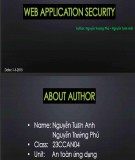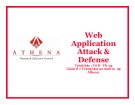
This framework is provided with the CD-ROM. You don’t need to create it
from scratch.Also note that the database abstraction uses DB.php from the
PEAR.
Now let’s create the classes needed to implement this application framework.
Creating a Database
Abstraction Class
Accessing a database using its own API is common in the PHP world. For example,
most PHP developers use PHP with MySQL and, therefore, they write code that is
specific to the MySQL API found in PHP.
There is nothing wrong with this approach if you know that your PHP applica-
tions will be used only for the MySQL database server. However, if there is a chance
that your applications will be used with other databases such as Oracle, Postgres,
and so forth, you need to avoid MySQL-specific API. A developer who has
abstracted the database API in a level above the vendor-specific API can enjoy the
speed of porting the application to different relational databases. Here, we will cre-
ate a class called class.DBI.php that will implement a database abstraction layer for
our application framework. Listing 4-1 shows class.DBI.php, which implements
the database abstraction using PEAR DB.
See http://pear.php.net/manual/en/core.db.php for details on
PEAR DB, a unified API for accessing SQL-databases.
Listing 4-1: class.DBI.php
<?php
/*
Database abstraction class
Purpose: this class provides database abstraction using the PEAR
DB package.
Continued
Chapter 4: Architecture of an Intranet Application 71
07 549669 ch04.qxd 4/4/03 9:24 AM Page 71

Listing 4-1 (Continued)
*/
define(‘DBI_LOADED’, TRUE);
class DBI {
var $VERSION = “1.0.0”;
function DBI($DB_URL)
{
$this->db_url = $DB_URL;
$this->connect();
if ($this->connected == TRUE)
{
// set default mode for all resultset
$this->dbh->setFetchMode(DB_FETCHMODE_OBJECT);
}
}
function connect()
{
// connect to the database
$status = $this->dbh = DB::connect($this->db_url);
if (DB::isError($status))
{
$this->connected = FALSE;
$this->error = $status->getMessage();
} else {
$this->connected = TRUE;
}
return $this->connected;
}
function isConnected()
72 Part II: Developing Intranet Solutions
07 549669 ch04.qxd 4/4/03 9:24 AM Page 72

{
return $this->connected;
}
function disconnect()
{
if (isset($this->dbh)) {
$this->dbh->disconnect();
return 1;
} else {
return 0;
}
}
function query($statement)
{
$result = $this->dbh->query($statement);
if (DB::isError($result))
{
$this->setError($result->getMessage());
return null;
} else {
return $result;
}
}
function setError($msg = null)
{
global $TABLE_DOES_NOT_EXIST, $TABLE_UNKNOWN_ERROR;
$this->error = $msg;
if (strpos($msg, ‘no such table’))
{
$this->error_type = $TABLE_DOES_NOT_EXIST;
} else {
Continued
Chapter 4: Architecture of an Intranet Application 73
07 549669 ch04.qxd 4/4/03 9:24 AM Page 73

Listing 4-1 (Continued)
$this->error_type = $TABLE_UNKNOWN_ERROR;
}
}
function isError()
{
return (!empty($this->error)) ? 1 : 0;
}
function isErrorType($type = null)
{
return ($this->error_type == $type) ? 1 : 0;
}
function getError()
{
return $this->error;
}
function quote($str)
{
return “‘“ . $str . “‘“;
}
function apiVersion()
{
return $VERSION;
}
}
?>
Here are the functions the DBI class implements:
◆DBI():This is the constructor method, which creates the instances of the
DBI object. For example, here is a script called test_dbi.php that creates a
DBI object.
<?php
// Turn on all error reporting
error_reporting(E_ALL);
// If you have installed PEAR packages in a different
// directory than %DocumentRoot%/pear change the
74 Part II: Developing Intranet Solutions
07 549669 ch04.qxd 4/4/03 9:24 AM Page 74

// setting below.
$PEAR_DIR = $_SERVER[‘DOCUMENT_ROOT’] . ‘/pear’ ;
// If you have installed PHPLIB in a different
// directory than %DocumentRoot%/phplib, change
// the setting below.
$PHPLIB_DIR = $_SERVER[‘DOCUMENT_ROOT’] . ‘/phplib’;
// If you have installed framework directory in
// a different directory than
// %DocumentRoot%/framework, change the setting below.
$APP_FRAMEWORK_DIR=$_SERVER[‘DOCUMENT_ROOT’] . ‘/framework’;
// Create a path consisting of the PEAR,
// PHPLIB and our application framework
// path ($APP_FRAMEWORK_DIR)
$PATH = $PEAR_DIR . ‘:’ .
$PHPLIB_DIR . ‘:’ .
$APP_FRAMEWORK_DIR;
// Insert the path in the PHP include_path so that PHP
// looks for our PEAR, PHPLIB and application framework
// classes in these directories
ini_set( ‘include_path’, ‘:’ .
$PATH . ‘:’ .
ini_get(‘include_path’));
// Now load the DB.php class from PEAR
require_once ‘DB.php’;
// Now load our DBI class from application framework
// directory
require_once(‘class.DBI.php’);
// Set the database URL to point to a MySQL
// database. In this example, the database is
// pointing to a MySQL database called auth on
// the localhost server, which requires username
// (root) and password (foobar) to login
$DB_URL = ‘mysql://root:foobar@localhost/auth’;
// Create a DBI object using our DBI class
// Use the database URL to initialize the object
// and make connection to the database
$dbi = new DBI($DB_URL);
Chapter 4: Architecture of an Intranet Application 75
07 549669 ch04.qxd 4/4/03 9:24 AM Page 75











![Tài liệu ôn tập môn Lập trình web 1 [mới nhất/chuẩn nhất]](https://cdn.tailieu.vn/images/document/thumbnail/2025/20251208/hongqua8@gmail.com/135x160/8251765185573.jpg)









![Hệ thống quản lý cửa hàng bán thức ăn nhanh: Bài tập lớn [chuẩn nhất]](https://cdn.tailieu.vn/images/document/thumbnail/2025/20251112/nguyenhuan6724@gmail.com/135x160/54361762936114.jpg)
![Bộ câu hỏi trắc nghiệm Nhập môn Công nghệ phần mềm [mới nhất]](https://cdn.tailieu.vn/images/document/thumbnail/2025/20251111/nguyenhoangkhang07207@gmail.com/135x160/20831762916734.jpg)



